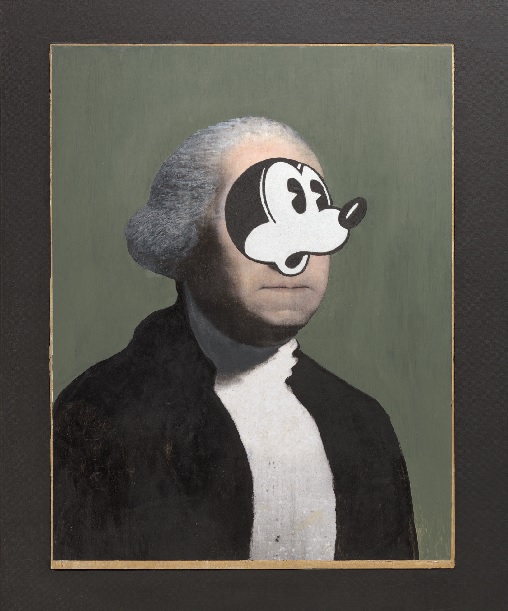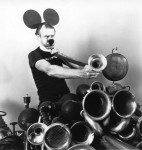
Llyn Foulkes
American, 1934-
Mr. President, 2006
oil and acrylic on wood, mounted on canvas
40 x 40 in.
SBMA, Museum Purchase, Wright S. Ludington Acquisition Fund
2010.58

Undated photo
"Painting is my torment, music is my joy." - Lynn Foulkes
COMMENTS
The cartoon-serious urgency of titles such as “I Got a Job to Do” and “You Would Not Listen When I Told You,” are a welcome invitation into the world of a radically fresh 73-year-old painter, who is not as well-known as he should be on the East Coast. The artist is Llyn Foulkes, a Zelig-like character who has continually reinvented himself and his artistic practice over the course of five decades.
Foulkes is a beloved troubadour survivor of the 1960s L.A. Pop Art scene and a close affiliate of artists such as John Baldessari, Ed Ruscha, Wallace Berman and Robert Irwin. After dropping out of Chouinard Art Institute (later known as CalArts) in 1959, Foulkes had his first solo exhibition at Ferus Gallery in 1961, a year before Andy Warhol’s "Soup Cans" debuted there, and continued to show extensively in Europe and America throughout the decade. A popular early hit was “Cow” (1963), an Ab-Ex meets folk-art painting of a cow that preceded Warhol’s flashy bovine wallpaper by three years. The show at Kent Gallery brings together twenty mixed-media paintings on wood panels created between 2003 and 2007. In line with his 1960s work, Foulkes sidesteps Pop Art’s polished image reproduction in order to lend new relevancy to the formal tropes of Dada collage and assemblage art.
The paintings range from the modest scale of a household altarpiece to the expansiveness of a rugged bulletin board, complete with aging postcards, line drawings, and found photographs. One of the more shocking revelations of the show is the potency that Foulkes restores to a primal symbol of corporate culture: Mickey Mouse. In “Mr President” (2006) a portrait of George Washington is defaced by a collaged cut-out of an earless, mouth agape Mickey Mouse. The pairing of two iconic images doesn’t yield to an easy Pop Art interpretation. Instead it is an odd combination of jubilation and terror—junk store brashness mixed with a technical virtuosity and draftsmanship that belies a profound commitment to the visual language of painted images. The illusionist wooden frame around the image of Washington is a repeated motif in many of the paintings. Craftily formatted panels embedded into larger panels, further heighten the dizzying spatial ambiguity of the image plane.
- Nora Griffin, "Llyn Foulkes," The Brooklyn Rail, October 3, 2007
http://www.brooklynrail.org/2007/10/artseen/llyn-foulkes
SBMA CURATORIAL LABELS
A stately portrait of George Washington by Gilbert Stuart stresses the power and authority of the presidency, while Mickey Mouse is a sign of giggly innocence. In Foulkes’ hands, however, Mickey becomes menacing and scary, while the president becomes a clown. The artist’s satire does double duty. It deflates the pomposity and power of the presidency but also looks askance at the corporate moneymaking and marketing agendas behind the saccharine figure of a squeaky cartoon mouse. Foulkes developed an antipathy for the Disney character after he read the first page from the 1934 Mickey Mouse Club handbook. He recalls recoiling at “its blatant mission to ‘implant beneficial principles’ into the minds of children.” Appearances deceive, the artist seems to say. A mouse can wield unconscious influence over its audience or a president’s authority, and power can be paper thin.
- Park Projects, 2020
